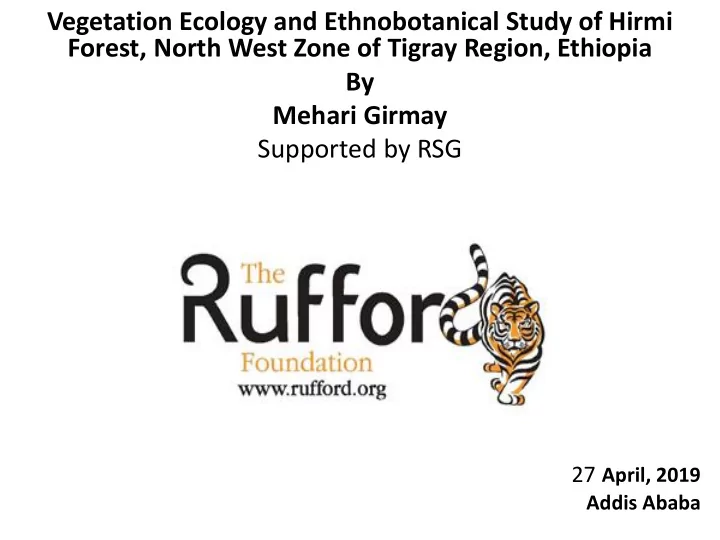

Vegetation Ecology and Ethnobotanical Study of Hirmi Forest, North West Zone of Tigray Region, Ethiopia By Mehari Girmay Supported by RSG 27 April, 2019 Addis Ababa
Introduction Diverse physiographic and climatic features of the country; formation of different ecosystems imposes to have species diversity Vegetation cover of an area has; definite structure and composition developed as a result of long-term interaction of biotic and abiotic factors 2
Why this study Habitat degradation & Current global deforestation attention, constitute about 65 % of conservation of dry land ecosystem the landmass Ethiopia affect the capacity of (coverage, rich BD, forests to provide ecosystem (Demel Teketay, 2001). socio-economic & services cultural value ) (CBD, 2006) lack of adequate understanding on biological resources & interaction with the environment ; Following the long history of land degradation, many land rehabilitation & conservation programs have been carried out challenges implementing effective policies in N. Ethiopia (EFAP, 1994) for the sustainable utilization and conservation of biodiversity 3
Objectives The Study 1. To asses floristic composition and diversity of Hirmi forest. 2. To see the distribution of plant community in relation to the environmental variables. 3. To assess the major threats to forest 4. Assess the knowledge, utilization and management practices for medicinal plants of Hirmi forest by the surrounding community. 5. Recommend appropriate methods and approaches of conservation to the concerned body (researchers, policy makers, local community … ) 4
Description of the study area • Hirmi forest is found North West Zone-Tigray • Latitude 13 ⁰ 49 ' – 14 ⁰ 04 ' of N&longitude of 38 ⁰ 14 ' – 38 ⁰ 25 ' E • The total forest area = 239.84 km 2 located in 12 kebeles of three woreda. • Vegetation - Acacia-Comiphora Combretum – woodland and Terminalia woodland type 5
Ethnobotanical data- from 6 Kebele(small administrative villages) 370 HH was taken from the total of 4,868 population via 𝐨 = 𝐎 𝟐+𝐎(𝐟) 𝟑 - 94 species was recorded
• about 60% of the community is used herbal medicine to treat for both human and animal disease • people in the community are who have good awareness on those herbal medicinal plants have good perception toward their conservation
Top X m . representativeness homogeneity veg. Plot 1 X m . Plot 2 8 Down
DBH, species abundance, density and tertian variables affect the plans biodiversity was also measured Measuring of DBH Slope recording
• 10 transect was laid • 204 species in 75 plots was collected • 90 families and 101 genera • Poaceae(14.5%) Combretaceae(14%), • Fabaceae(12%), Asteraceae(11%) • Moraceae (8%), Lamiaceae(6.1%) • Rubiaceae(5.5%) and Ebenaceae(4.1%). • The rest 24.8 % plant families were belongs to other different families.
• About 75 soil samples from each vegetation quadrant were taken for various soil chemistry parameters laboratory analysis and correlate with vegetation distribution in Shire agricultural research center
As result, a sandy loam type of soil is the major soil type The rest of parameters was associated with species distribution
Deduction • This study is PhD dissertation work • Currently this work is under analysis and writing up • All the scientific finding, recommendation will be disseminate either in publication articles, in workshops, or train to the local community on approaches and mechanisms of sustainable conservation and utilization of the forest ecosystem (nature in general)
Recommendation and Acknowledgment to RSG • I have a great appreciation and grateful for RSG for its commitment in supporting nature conservation works • Conserving of nature enable to eradicate poverty and balance the global climate change • RSG should expand the startup activities to mainstream all the conservation works with frequent monitoring and follow-up • Wish to boost and continue all relevant studies
The End Conserving of nature at local level brings global changes
Recommend
More recommend